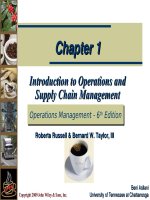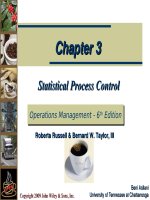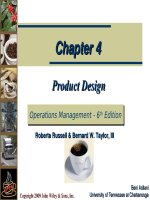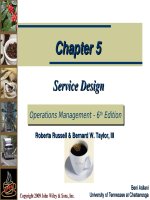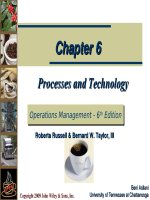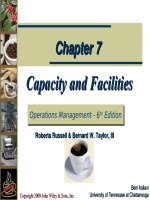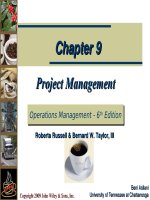Enterprise systems for management 2nd by motiwalla and thompson chapter 06
Bạn đang xem bản rút gọn của tài liệu. Xem và tải ngay bản đầy đủ của tài liệu tại đây (179.63 KB, 19 trang )
CHAPTER 6
SOFTWARE AND
VENDOR SELECTION
1
Copyright © 2012 Pearson Education, Inc. Publishing as Prentice Hall
Learning Objectives
• Understand the initial steps in the process for the
successful purchase and implementation of an ERP
system.
• Determine the total cost of ownership and what it is to
partner with an ERP vendor.
• Understand why the first steps in the purchase of an
ERP are critical to the change management process.
• Identify the steps involved in negotiating a contract with
a vendor.
2
Copyright © 2012 Pearson Education, Inc. Publishing as Prentice Hall
Preview
• The selection of a vendor that best meets the needs
and long-term direction of the company is a critical first
step in a successful implementation.
• In selecting a vendor, a well-understood selection
process will need to be utilized.
• The company may want to hire a specialized consulting
firm to assist in the selection process.
• The steps involved in selecting a vendor generally are
based on best fit of an ERP to business functions and
the overall ERP vendor’s product performance in the
market.
3
Copyright © 2012 Pearson Education, Inc. Publishing as Prentice Hall
High Level ERP Purchase Process
1.
2.
3.
4.
5.
6.
Vendor research and information gathering
High-level vendor demonstrations and evaluation
Needs and requirements assessment
Development of request for bid or proposal
Release request for bid to vendors
Analysis and selection- Evaluation of bids, Functional
evaluation, Technical evaluation, Vendor-detailed
demonstrations, Contact references, Develop a total
cost of ownership
7. Vendor negotiation,
a) Contract review and change,
b) Pricing- software, maintenance, and consulting, support
8. Purchase system
4
Copyright © 2012 Pearson Education, Inc. Publishing as Prentice Hall
Vendor Research
• First step is to identify a short list of vendors who will help to
shape business requirements.
• Identifying and researching all aspects of a vendor package
will assist companies in determining the total cost of
ownership.
• An exhaustive list of vendors is important for a successful
implementation using current web search engines.
• Ask department managers and subject matter experts for
their input in vendor selection.
• Including end-users will help with change management and
also help to gain trust for later in the implementation.
5
Copyright © 2012 Pearson Education, Inc. Publishing as Prentice Hall
Vendor Research (Cont’d)
• Consider the following for vendor selection.
– Other businesses using the vendor
– The vendor’s financial position
– The vendor’s implementation philosophy and support issues
– The hardware and software infrastructure used to support the
ERP
– The vendor’s direction and currency of software
– The vendor’s release and upgrade strategies
– The vendor’s user-base involvement in defining future
functional changes
– The vendor’s development and maintenance resources
6
Copyright © 2012 Pearson Education, Inc. Publishing as Prentice Hall
Short List of ERP Vendors
• SAP—Solutions are for all types of industries and for
every major market. Its products include mySAP
Business Suite, SAP NetWeaver, and solutions for
small and midsize companies (e.g., SAP Business One
and SAP All-in-One).
• Oracle/PeopleSoft — (Acquired PeopleSoft in 2004)
Provides solutions divided by industry category.
• Lawson —Provides industry tailored software
solutions.
• SSA Global—(Acquired Baan in 2004.) Claim to offer
solutions that accomplish specific goals in shorter time
frames.
7
Copyright © 2012 Pearson Education, Inc. Publishing as Prentice Hall
Short List of ERP Vendors (Cont’d)
• Great Plains- Part of the Microsoft Business Solutions
group of products, its solutions can be tailored
according to business needs.
• Epicor- Focuses on enterprise software solutions for
mid-market companies.
• Infor Visual- Flexible, fully integrated, and easy-to-use
ERP suite that is widely deployed across many
industries from aerospace to biomedical, capital
equipment, precision tools etc.
• Plex Online- Plex Online provides a full suite of
enterprise resource planning, manufacturing execution
system, and supply chain management solutions
8
Copyright © 2012 Pearson Education, Inc. Publishing as Prentice Hall
Matching User Requirements to Features
• Identification and documentation of user and system
requirements can be done by documenting current
legacy system functionality or by using business
process re-engineering.
• Two major documents are often a result:
– Data and functional flow of departmental or business
processes.
– Table or description of functions in each department and the
level of importance of each function.
• Identifying vendor system functionality based on
documented processes will help to purchase a system
based on facts.
9
Copyright © 2012 Pearson Education, Inc. Publishing as Prentice Hall
Request for Bids (RFB)
• Often known as Request for Proposals (RFP)
• Expensive and time-consuming process for both the
company and vendor, but it can yield significant
software savings when done right.
• RFB should always include the following:
– Type of ERP system the company wants with specific
functionality
– Specified hardware and software infrastructure
– Training requirements
– Any specific contract issues required by the company
10
Copyright © 2012 Pearson Education, Inc. Publishing as Prentice Hall
Vendor Analysis and Elimination
• Office staff will need to evaluate functionality.
• IT staff will evaluate the technology requirements.
• Contract staff will need to evaluate the contract and
pricing of the system.
• No vendor will meet all requirements so vendor
discussions and negotiations should focus on the best
fit for the business.
• Develop and analyze the total cost of ownership
(TCO).
11
Copyright © 2012 Pearson Education, Inc. Publishing as Prentice Hall
Contract Management and License Agreements
• Talks should center on the products included in the
purchase and maintenance terms of each product.
• Professional services for the implementation or
installation can be included or bid separately.
• Contract life cycle management will need to be addressed
during contract talks.
• Things every ERP contract should have:
– All deliverables must be clearly identified with delivery dates
associated.
– Ensure that you, the customer, have acceptance authority.
– Identify those responsible on both sides for contract management
and who has the authority to authorize changes to the contract.
12
Copyright © 2012 Pearson Education, Inc. Publishing as Prentice Hall
Contract Management and License Agreements (Cont’d)
• A quality manager or contract monitor appointed by the
program manager will have primary responsibility for
making sure both sides abide by the terms and
conditions of the contract.
• Changes should only be made when necessary due to
unforeseen circumstances, mutually beneficial
reasons, or unintended mistakes.
• Communicating progress keeps all involved and will
also help to maintain momentum.
• It is best to over-communicate during this phase:
Communicating progress keeps everyone involved
13
Copyright © 2012 Pearson Education, Inc. Publishing as Prentice Hall
Implications for Management
• Management must play a role in choosing the right
system that will meet the company’s needs and
requirements.
• Management must allocate enough time to evaluate
the system, observe a complete and comprehensive
demonstration, and communicate to references and
others using the system.
• Discussions with the vendor about future
improvements and direction must be scheduled.
• Negotiating with two vendors is time-consuming, but it
will yield a better purchase price.
14
Copyright © 2012 Pearson Education, Inc. Publishing as Prentice Hall
Summary
• The majority of ERP systems today are purchased
• Steps involved in purchasing a system include:
– Vendor research
– Defining business requirements
– Requesting information
– Matching requirements to system functions
– Request for bids
– Analyzing vendors
– Meeting business needs
– Determining total cost of ownership
– Negotiating a contract and license agreement
15
Copyright © 2012 Pearson Education, Inc. Publishing as Prentice Hall
Summary (Cont’d)
• A business must deal in facts with every step of
purchasing an ERP system. A decision will be made
based on:
– Gathering information
– Researching vendors
– Documenting business processes
– Reviewing vendor bids.
• During the implementation phase, it is important to
know detailed information on ERP system functionality
and business requirements as it is the basis for setting
implementation expectations.
16
Copyright © 2012 Pearson Education, Inc. Publishing as Prentice Hall
Review Questions
1. What are the steps in purchasing an ERP?
2. Who generally needs to be involved in the ERP
selection process and why?
3. What is total cost of ownership (TCO) and why should
it be a part of the ERP selection process?
4. What are the key components in the contract
negotiation and licensing?
5. Why is it important in the request for bid process to
make the vendors reply in a specified format?
17
Copyright © 2012 Pearson Education, Inc. Publishing as Prentice Hall
Review Questions (Cont’d)
6. Why is communication important in this phase?
7. What is the difference between RFI and RFB?
8. What are the benefits of a bidding process to
purchase an ERP?
18
Copyright © 2012 Pearson Education, Inc. Publishing as Prentice Hall
All rights reserved. No part of this publication may be reproduced, stored in a
retrieval system, or transmitted, in any form or by any means, electronic,
mechanical, photocopying, recording, or otherwise, without the prior written
permission of the publisher. Printed in the United States of America.
Copyright © 2012 Pearson Education, Inc.
Publishing as Prentice Hall
19
Copyright © 2012 Pearson Education, Inc. Publishing as Prentice Hall


